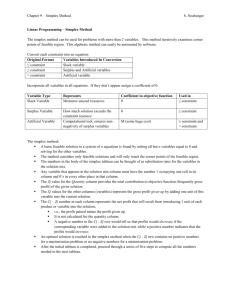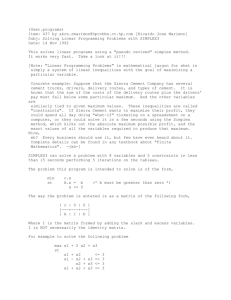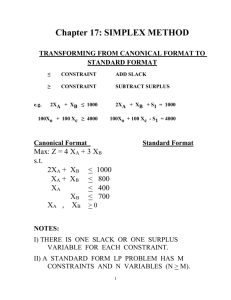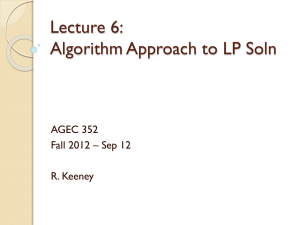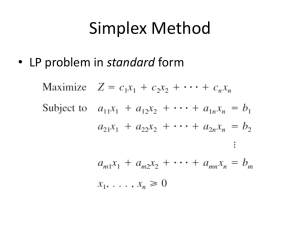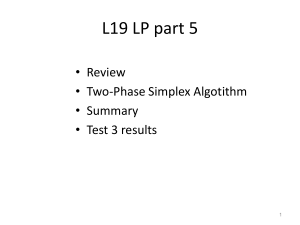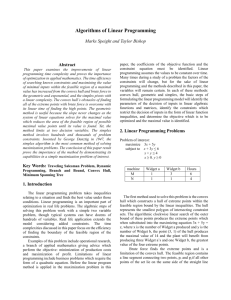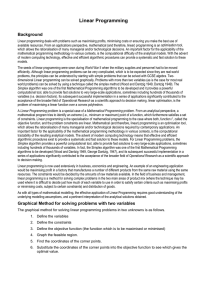PPT
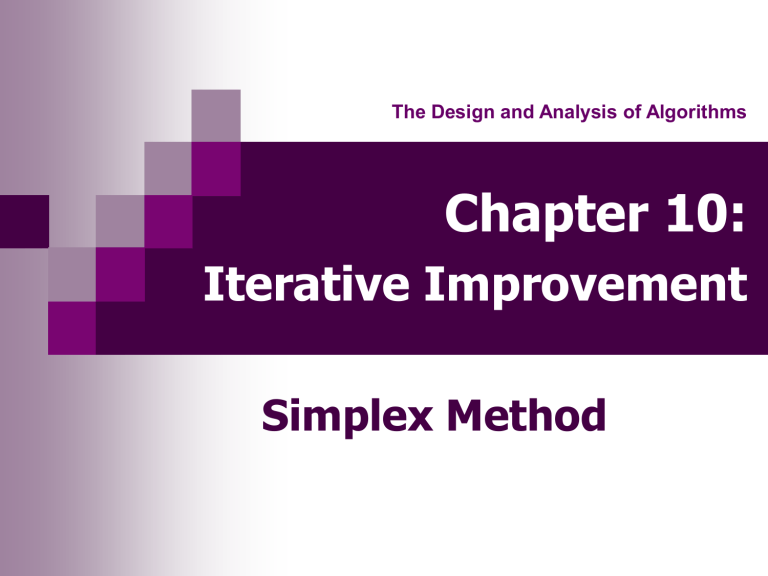
The Design and Analysis of Algorithms
Chapter 10:
Iterative Improvement
Simplex Method
Iterative Improvement
Introduction
Linear Programming
The Simplex Method
Standard Form of LP Problem
Basic Feasible Solutions
Outline of the Simplex Method
Example
Notes on the Simplex Method
Improvements
2
Introduction
Algorithm design technique for solving optimization problems
Start with a feasible solution
Repeat the following step until no improvement can be found: change the current feasible solution to a feasible solution with a better value of the objective function
Return the last feasible solution as optimal
3
Introduction
Note: Typically, a change in a current solution is “small” ( local search )
Major difficulty: Local optimum vs. global optimum
4
Important Examples
Simplex method
Ford-Fulkerson algorithm for maximum flow problem
Maximum matching of graph vertices
Gale-Shapley algorithm for the stable marriage problem
5
Linear Programming
Linear programming (LP) problem is to optimize a linear function of several variables subject to linear constraints: maximize (or minimize) c subject to
1 a i1 x
1 x
1
+ ...+ c
+ ...+ a in n x n x n
≤ (or ≥ or =) b i
i = 1,...,m , x
1
≥ 0, ... , x n
≥ 0
,
The function z = c
1 x
1
+ ...+ c n x n is called the objective function ; constraints x
1
≥ 0 , ... , x n
≥ 0 are called non-negativity constraints
6
maximize 3x + 5y subject to x + y ≤ 4 x + 3y ≤ 6 x ≥ 0, y ≥ 0 y x + 3y = 6
( 0, 2 )
( 0, 0 )
Example
Feasible region is the set of points defined by the constraints
( 3, 1 )
( 4, 0 ) x + y = 4 x
7
maximize 3x + 5y subject to x + y ≤ 4 x + 3y ≤ 6 x ≥ 0, y ≥ 0
Geometric solution
y
Extreme Point Theorem Any LP problem with a nonempty bounded feasible region has an optimal solution; moreover, an optimal solution can always be found at an extreme point of the problem's feasible region.
( 0, 2 )
( 3, 1 )
( 0, 0 )
( 4, 0 ) x
3x + 5y = 20
3x + 5y = 14
3x + 5y = 10
8
Possible outcomes in solving an LP problem
has a finite optimal solution , which may not be unique
unbounded : the objective function of maximization (minimization) LP problem is unbounded from above (below) on its feasible region
infeasible : there are no points satisfying all the constraints, i.e. the constraints are contradictory
9
The Simplex Method
Simplex method is the classic method for solving
LP problems, one of the most important algorithms ever invented
Invented by George Dantzig in 1947 (Stanford
University)
Based on the iterative improvement idea:
Generates a sequence of adjacent points of the problem’s feasible region with improving values of the objective function until no further improvement is possible
10
Standard form of LP problem
• must be a maximization problem
• all constraints (except the non-negativity constraints) must be in the form of linear equations
• all the variables must be required to be nonnegative
Thus, the general linear programming problem in standard form with m constraints and n unknowns ( n ≥ m ) is maximize c
1 x subject to a i1 x
1
1
+ ...+ c
+ ...+ a in n x n x n
= b i
, , i = 1,..., m , x
1
≥ 0, ... , x n
≥ 0
Every LP problem can be represented in such form
11
Example
maximize 3x + 5y maximize 3x + 5y + 0u + 0v subject to subject to x + y ≤ 4 x + y + u = 4 x + 3 y ≤ 6 x ≥0, y ≥0 x x
≥0,
+ 3 y y +
≥0, u v
≥0, v
= 6
≥0
Variables u and v , transforming inequality constraints into equality constrains, are called slack variables
12
Basic feasible solutions
A basic solution unknowns ( n ≥ to a system of m m linear equations in
) is obtained by setting n – m n variables to 0 and solving the resulting system to get the values of the other m variables.
The variables set to 0 are called nonbasic ; the variables obtained by solving the system are called basic .
A basic solution is called are nonnegative.
Example feasible if all its (basic) variables x + y + u = 4 x + 3 y + v = 6
(0, 0, 4, 6) is basic feasible solution
( x , y are nonbasic; u , v are basic)
13
maximize
z = 3x + 5y + 0u + 0v subject to
x + y + u = 4
x + 3y + v = 6 x ≥0, y≥0, u≥0, v≥0
Simplex Tableau
14
Outline of the Simplex Method
Step 0 [Initialization] Present a given LP problem in standard form and set up initial tableau.
Step 1 [Optimality test] If all entries in the objective row are nonnegative — stop: the tableau represents an optimal solution.
Step 2 [Find entering variable] Select (the most) negative entry in the objective row.
Mark its column to indicate the entering variable and the pivot column.
15
Outline of the Simplex Method
Step 3 [Find departing variable]
•For each positive entry in the pivot column, calculate the θ-ratio by dividing that row's entry in the rightmost column by its entry in the pivot column.
(If there are no positive entries in the pivot column — stop: the problem is unbounded.)
•Find the row with the smallest θ-ratio, mark this row to indicate the departing variable and the pivot row.
Step 4 [Form the next tableau]
• Divide all the entries in the pivot row by its entry in the pivot column.
• Subtract from each of the other rows, including the objective row, the new pivot row multiplied by the entry in the pivot column of the row in question.
• Replace the label of the pivot row by the variable's name of the pivot column and go back to Step 1.
16
maximize
z = 3x + 5y + 0u + 0v subject to
x + y + u = 4
x + 3y + v = 6 x ≥0, y≥0, u≥0, v≥0
Example of Simplex Method x y u v u 1 1 1 0 4 v 1 3 0 1 6
3 5 0 0 0 basic feasible sol.
(0, 0, 4, 6) z = 0 u y
4
3
1
3
2
3 x y u v
0 1
1 0
1
3
1
3
0 0
5
3
2
2
10 basic feasible sol.
(0, 2, 2, 0) z = 10 x x y u v
1 0 3/2 1/3 3 y 0 1 1/2 1/2 1
0 0 2 1 14 basic feasible sol.
(3, 1, 0, 0) z = 14
17
Notes on the Simplex Method
Finding an initial basic feasible solution may pose a problem
Theoretical possibility of cycling
Typical number of iterations is between m and
3 m , where m is the number of equality constraints in the standard form. Number of operations per iteration: O(nm)
Worse-case efficiency is exponential
18
Improvements
L. G. Khachian introduced an ellipsoid method (1979) that seemed to overcome some of the simplex method's limitations. O(n 6 ).
Disadvantage – runs with the same complexity on all problems
Narendra K. Karmarkar of AT&T Bell Laboratories proposed in1984 a new very efficient interior-point algorithm O(n 3.5
).
In empirical tests it performs competitively with the simplex method.
19
